Two (2) fantastic places to visit in the Peloponnese: Xylokastro & Trikala
The landscape in the Peloponnese around me is overwhelming and magnificent. I feel embraced by a force of nature that is barely tangible and which at the same time touches me deeply. I am in Trikala Korinth who climbs up the slope of Mount Ziria and creates a place I want to stay in forever. It feels like I’ve come home.
Read the article in Swedish here!
Xylokastro
The journey in the Peloponnese starts by the coast in the town of Xylokastro, about 30 kilometers from what I now want to call my home. The waves from the turquoise Gulf of Corinth roll in towards the land and meet a deep green pine forest next to bright houses. The visual impressions are powerful and the immediate thought is that I would like to get to know the city in depth. The desire to know more is strong and there is something special about the combination of sea, nature and buildings.
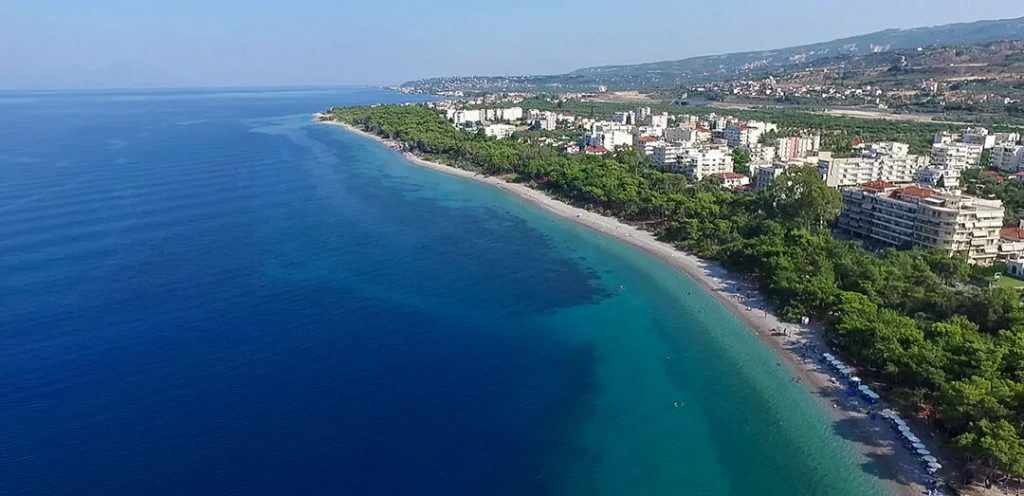
After the sea, the forest and the urban area come the fertile farms that supply fruit and grapes and not least the real delicacy of the area, corints. The rolling farmland transitions into mountain slopes, creating a region where the distance between mountains and sea is only 40 minutes.
The winds in the Gulf of Corinth create really good conditions for wind-demanding sports such as windsurfing and kitesurfing, and Xylokastro is an increasingly obvious choice for those who use the wind in their sports.

We start with a walk in the pine forest, Pefkias, the pride of Xylokastro. The forest runs like a vein between the sea and the city and is both the lungs of the city and its inhabitants. There are recreational opportunities and places to gather new energy and you can have a peaceful break from the everyday bustle and exhale.
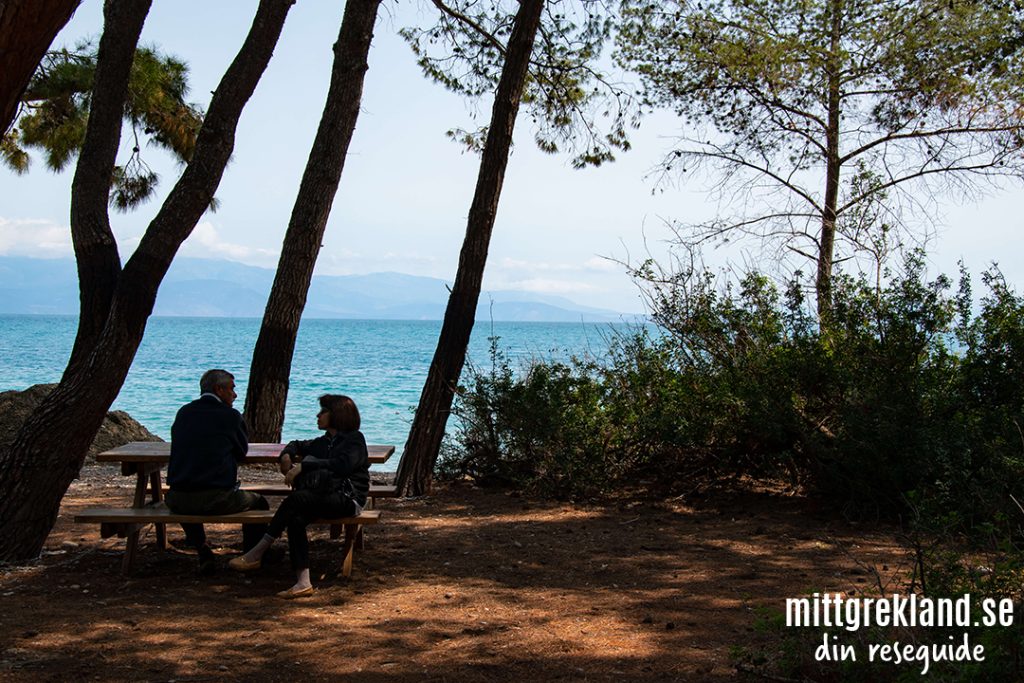
Pefkias was once considerably larger and stretched considerably further inland, but as the coast was populated and the population grew, the forest was decimated when the need for resin and wood outweighed the existence of the forest.
We can actually thank King Otto and Queen Amalia for the forest remaining. On a visit to the area, Queen Amalia was appalled by the massive felling and immediately ordered that all cutting of trees be banned. Forever. Thanks to the intervention of the royal couple, the remaining pine trees were protected and what we experience of Pefkias is the piece of forest that the royal couple saved.
The residence of the poet Angelos Sikelianos
We leave the pine forest behind and wander into a garden directly adjacent to the lush grove. The garden belongs to the house that the poet Angelos Sikelianos had built after being enchanted by the area.
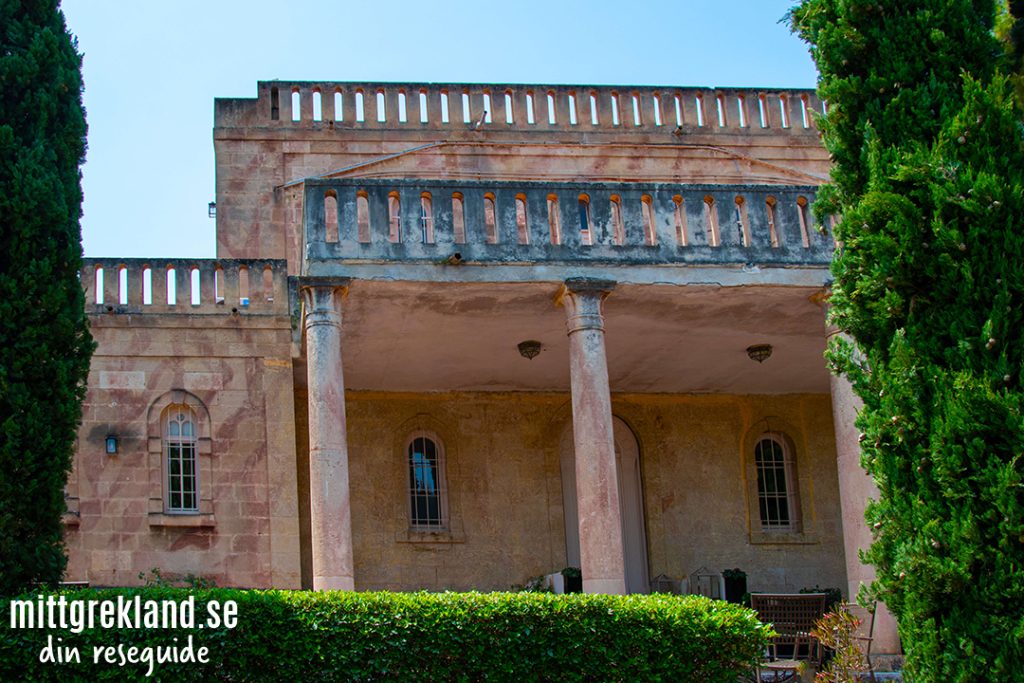
The house doesn’t conform to any specific era in architecture but instead Angelos combined characteristic details from different eras. For example, the columns show the connection to ancient Greece, the windows show the Byzantine era and the balconies have influences from Venice. The construction of the house took place between the years 1912 and 1916, and Angelos and his family lived in the house until 1930.
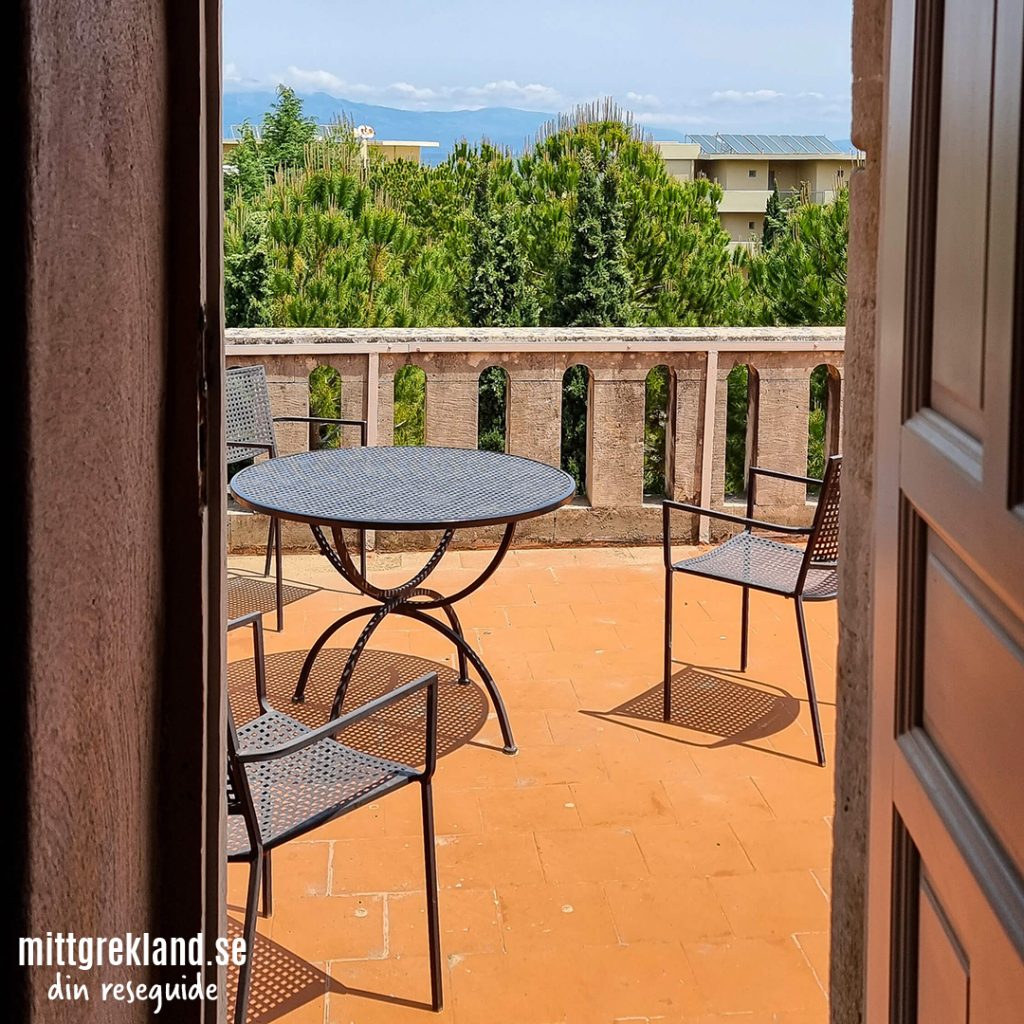
Over the years, the house has also housed others. During the Second World War the house was the headquarters of the Italian forces and during the Greek Civil War it was occupied by the rebels. As late as 1986 classified the Minister of Culture the building as a ”work of art” and as a ”historical monument”.
Today you can rent the upper floor as part of the Sikyon Coast Hotel & Resort (link). Talk about adding a historical feel to the hotel stay!
The Folklore Museum
Kamári has a relatively new folklore museum that was established in 2011. The initiative was taken by a primary school principal to preserve the everyday history and culture of the area for future generations.
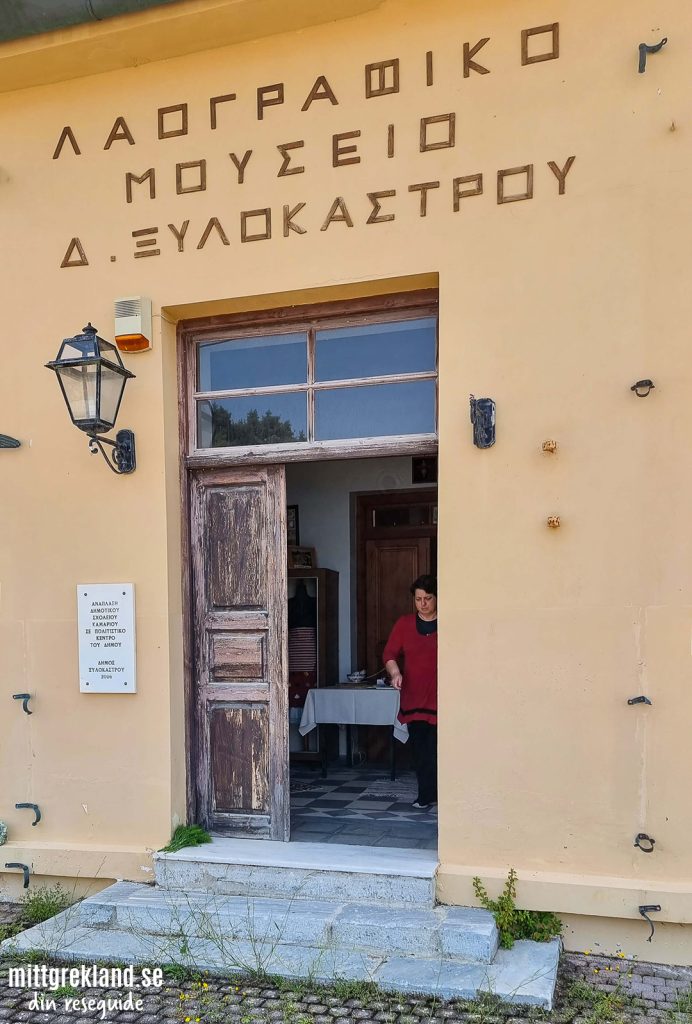
At the Folklore Museum you have the opportunity to learn about modern history through a solid collection that includes traditional costumes, everyday tools, needelwork and a range of other objects that tell the story of the lives of the local inhabitants.

The Folklore Museum in Kamári is located along the coastal road, just after the church of Agios Dimitrios. Opening hours vary and you need to ask if it is open or if it can be opened for a visit. There is an ambition to move the museum to the former Prime Minister Tsaldari’s house in Kamári (see below).

The residence of Prime Minister Tsaldaris
The house where Prime Minister Panagis Tsaldaris grew up is a beautiful old stone house from 1832. The house is currently closed to visitors but there is a plan to move the Folklore Museum here to gather the history of the village in one place.
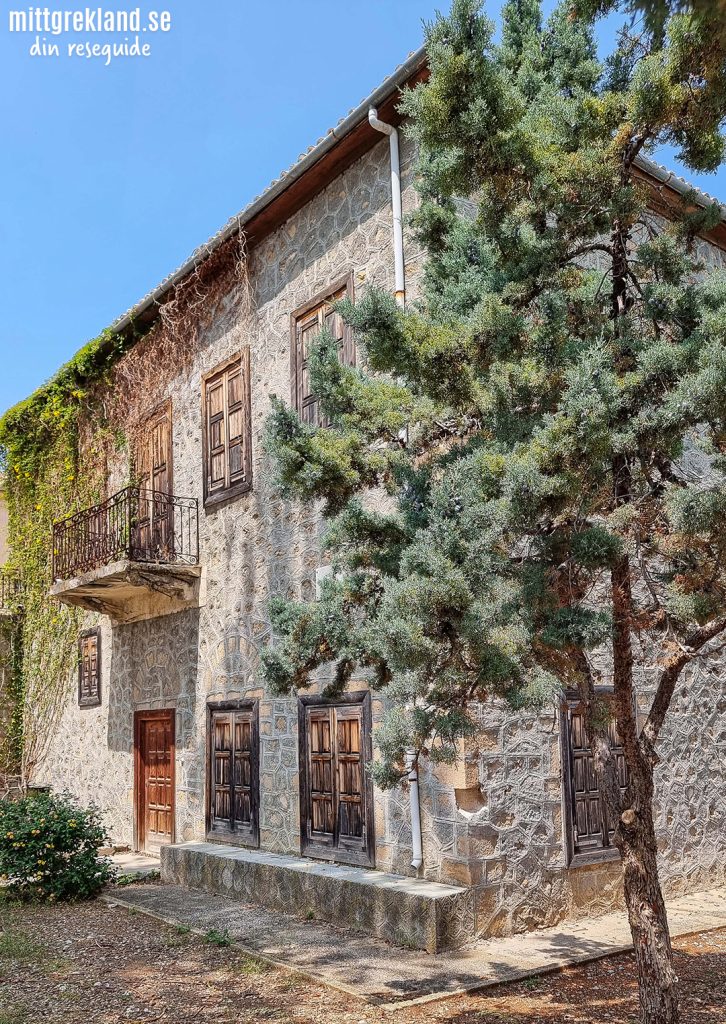
Panagis Tsaldaris was born in Kamári Peloponnese in 1868 and after his university studies in Athens and abroad, he began his professional career as a lawyer. His political career began in 1910 when he was elected to Parliament and later became Minister of Justice and then held the office of Prime Minister between 1932 to 1935.
A statue of Tsaldaris is next to his house in Kamári and in Xylokastro they have named their main street after him and has put a statue of him in the central square. There is a clear pride in the fact that Panagis Tsaldaris has grown up and lived in the area.
Evrostina
Panagia Katafygiotissa (Holy Mary of the shelters)
The white bus with tinted windows reaches its first stop, Panagia Katafygiotissa, where we get off at the widest part of the road. Wild, friendly cats greet us with their meowing accompanied by the whistling of the wind. Our small group is alone at the magnificent Byzantine monument embedded in the rocks of the mountain.
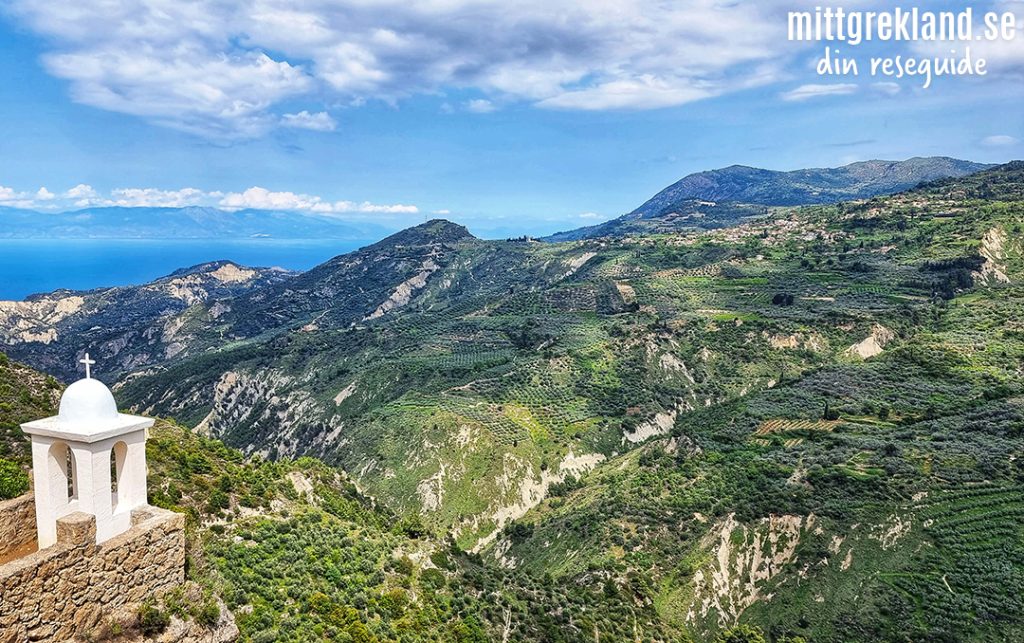
The chapel was built in 1782 and is the fruit of the local people’s devotion to their faith and their undoubted power to protect themselves against the persecution of the Turks. The inhabitants went up into the mountains to take shelter in caves or to carve out hollows to hide in, but they also sought a place to practice their religion, a place to pray for freedom.
Based on that, the chapel was built in honor of the Virgin Mary and was habited until 1880 by a single nun, but she abandoned the chapel due to the difficulties of living on the cliff ledge.
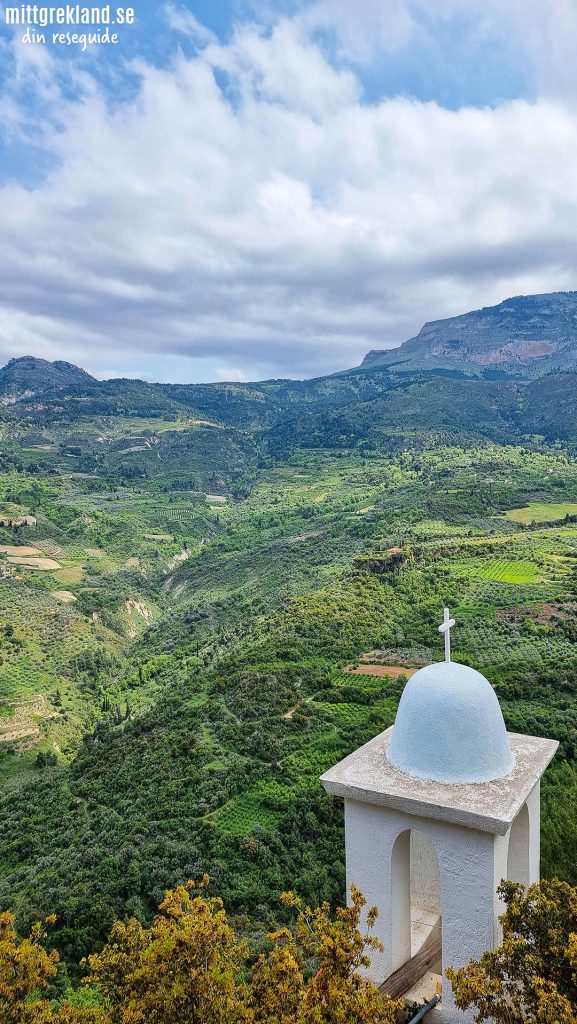
I would say that you don’t have to be religious to feel the attraction and spirituality of the place. It is a place to stop at, give time for reflection and to soak up the incredibly beautiful surroundings. The green slopes, the beige colored gorges and far away the blue sea in an unbeatable combination in the Peloponnese.
Church of Agios Georgios
Another church that is proof of will and cohesion is the church of Agios Georgios in the village of Evrostina. With its 17 domes, the church was built in just 39 days! An achievement that is well known throughout Greece.

But why build a church in 39 days? Well, the growing population could no longer be accommodated in the small chapel that existed in the village and a committee asked for approval from the governor of Corinth to build a new, larger church. The governor gave them permission to build the church, but under one condition: the church must be completed within 40 days or it would be demolished and replaced by a mosque.
With that decision, the whole village decided to help build the church, day and night, and amazingly they finished in 39 days. A collective force that showed the governor the determination, cohesion and strength of the Greeks not to be subdued.
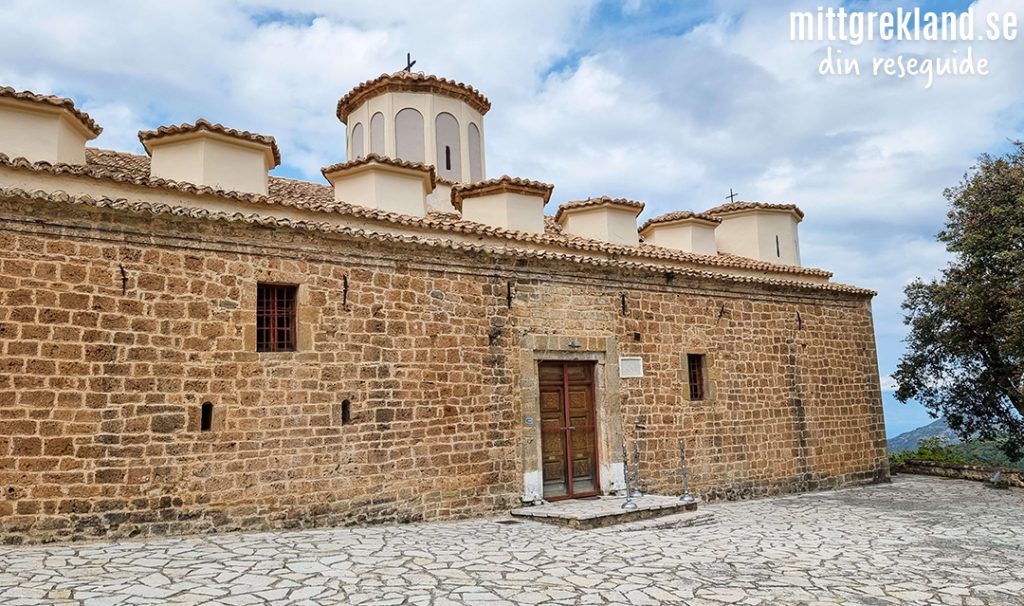
The 17 domes represent the twelve apostles and Jesus, with the largest dome symbolizing Jesus Christ. The four corner domes symbolize the four evangelists.
The screen-like wall with all the icons inside the church was created from a single cypress tree found in the village of Perdikari. According to legend, anyone who cuts down the tree would face death, but a brave old man volunteered to cut down the tree, thus defying the curse. The tree came to be used for the symbolic wall inside the church and despite the legend, the man survived for several years to come.
Agios Georgios also came to play another significant role, this time as the location of the first council of war during the 1821 revolution. A meeting that came to inspire the revolutionaries in their struggle for Greek independence.
Rema ton Mylon (Mill Stream)
Through (perhaps) the world’s steepest stone stairs, we descend from Agios Georgios to the village of Evrostina and further down to Rema ton Mykon (Mill Stream), a stream that flows in the gorge right next to the village. The connection to ”mill” comes from the time when the stream was used as power to drive a series of mills for various purposes.

It’s easy to be enchanted in this fairy-tale, lush environment with the rippling of the water as a meditative background. We stop for a while and a picnic is laid out in front of us with, among other things, lamb cooked in the traditional way in large metal containers directly on the embers.
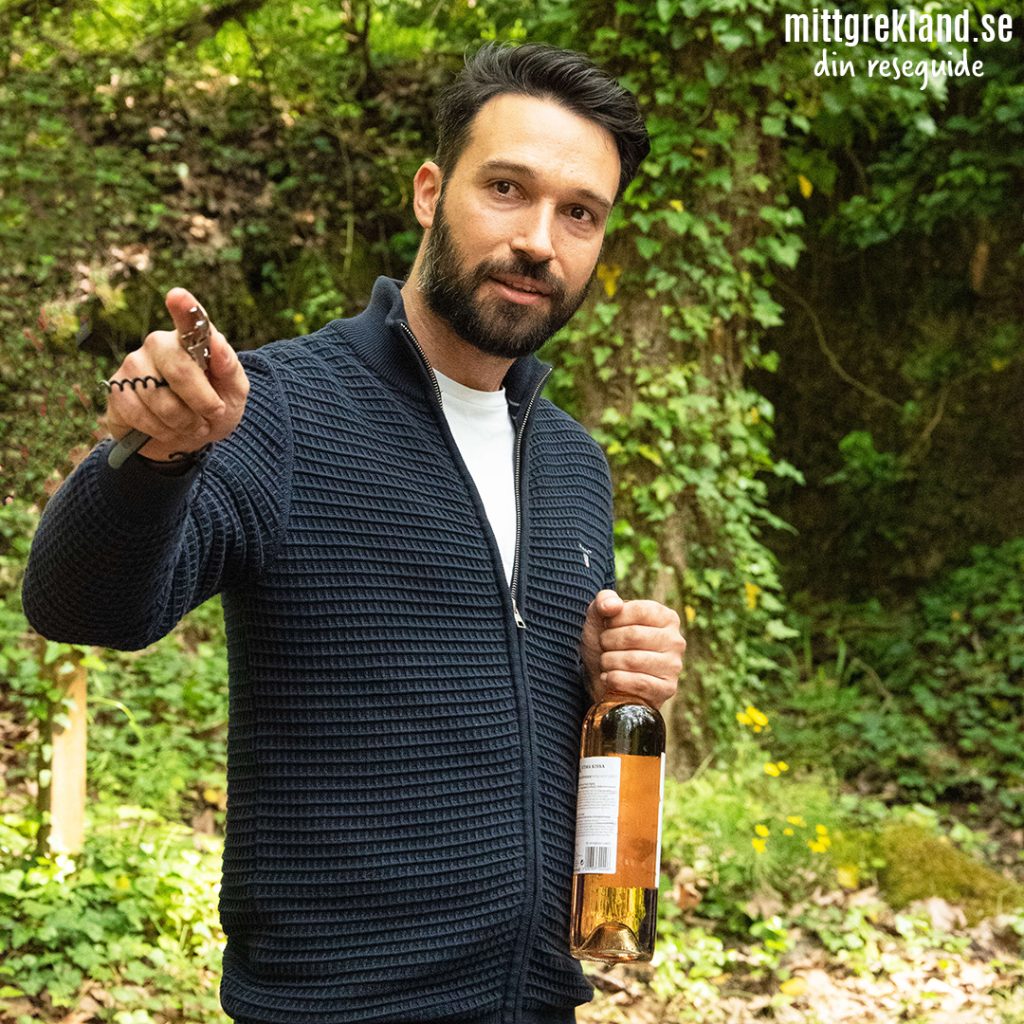
One of the area’s wineries, Ktima Kissa (link), proudly displays its wines and we get to taste the fresh white wine and the rosé wine Mikros Dromos. The winery is now run by third generation winemakers with vineyards that benefit from the climate on Ziria’s mountain slopes and the warm winds from the Gulf of Corinth. It’s kind of easy to enjoy yourself here.
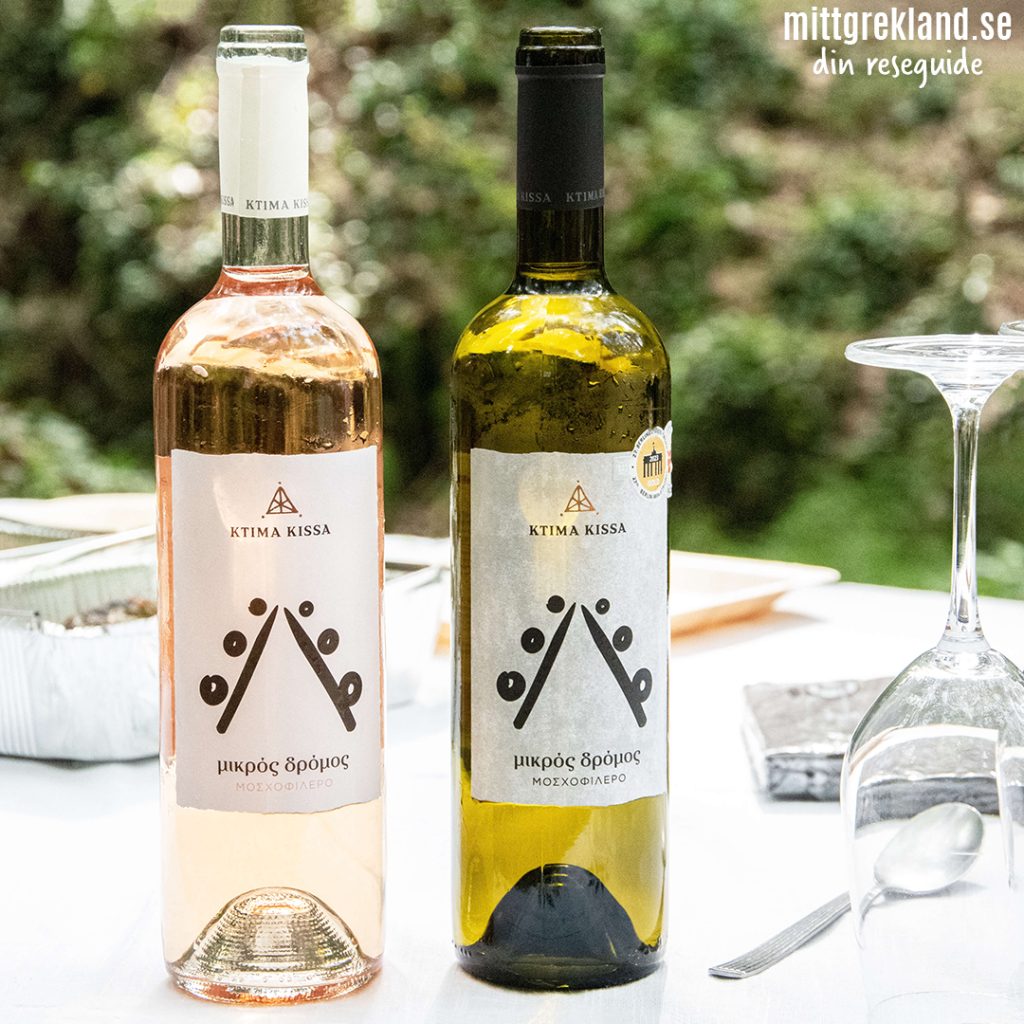
Trikala (Korinth/ Peloponnese)
“home”permanent residence for a certain person, family, etc.; often with that in mind
The definition of ”home” according to the Swedish dictionary (since I am Swedish) is that it is a permanent residence that you often think of. In this case, the thought of the place trumps the permanent residence because ever since I left Trikala, I have been thinking about this god-blessed place. And I can’t shake the feeling that it was like finding home. Strangely enough, I am now sitting in my permanent residence and longing to go home. I long for Trikala.
I have always liked the mountains and these mighty landscapes with a feeling that I belong in these surroundings. The higher up in the terrain our little bus takes us, the more my heart is filled with warmth and admiration. The landscape feels grand, overwhelming and at the same time so down to earth. Somehow, the boundaries between man and nature blur so slowly and I become a more tangible part of the surroundings.
Trikala is located along the slope of the mountain Ziria and is divided into three parts: Ano, Kato and Mesaia Trikala, i.e. ”upper, lower and middle”. Trikala actually means ”three beauties” and it is easy to understand. Not many souls live here and the facilities are limited, but so what? You don’t come here to shop, to stuff in rowdy bars or to elbow your way through crowds. You go here to be one with nature, feel the fresh oxygen fill your lungs, listen to the whistling of the wind and the chirping of the birds. You go here to experience a Greece far beyond the tourist tracks.
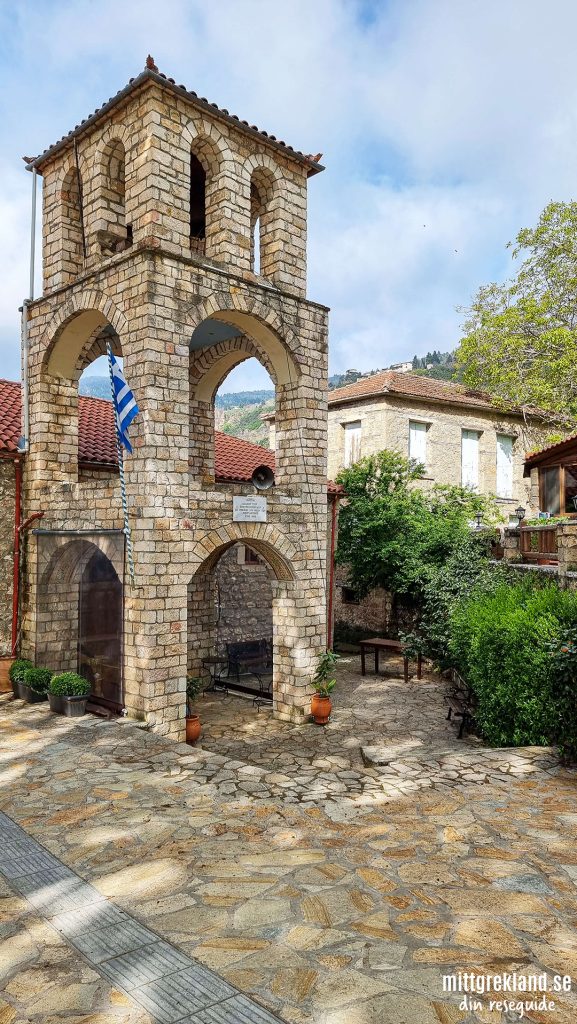
Trikala (Korinth/ Peloponnese) has relatively many accommodations for foreigners and is primarily a winter resort with the proximity to the Ziria Skicenter. The ambition is also to draw attention to Trikala as an attractive summer resort with hiking trails and various activities all over the mountain. I think they’re right about that because I can’t asseverate enough the area’s loveliness and views.
The food served in the taverns originates from local ingredients that are prepared with love and reverence. Despite its small size, there are several restaurants to choose from in Trikala and all of them serve food of really good quality.
Ziria Ski Center
You might not immediately associate Greece with skiing, but it does exist, and there is also really good skiing. One of the ski resorts in Greece and Peloponnese is Ziria and is about 45 minutes from Xylokastro down the coast. The ski center is not large but is aimed primarily for children and those who want to learn to ski. During the winter, you can also rent a scooter and go up to the lake Dasiou which is one of the few lakes that actually freezes in winter. For Greeks, being able to walk on ice is quite exotic.
During the summer you can rent a quad bike (buggy) and ride around the plateau formed next to the ridges. If you’re lucky, you can catch a glimpse of some of the hundreds of wild horses that live on the slopes of Mount Ziria, and don’t be surprised if you meet them while you’re right here at Ziria Ski Center (link). They like to keep their distance, but surely it is quite a powerful beeing in nature together with wild horses?
Free Horse Riding Center
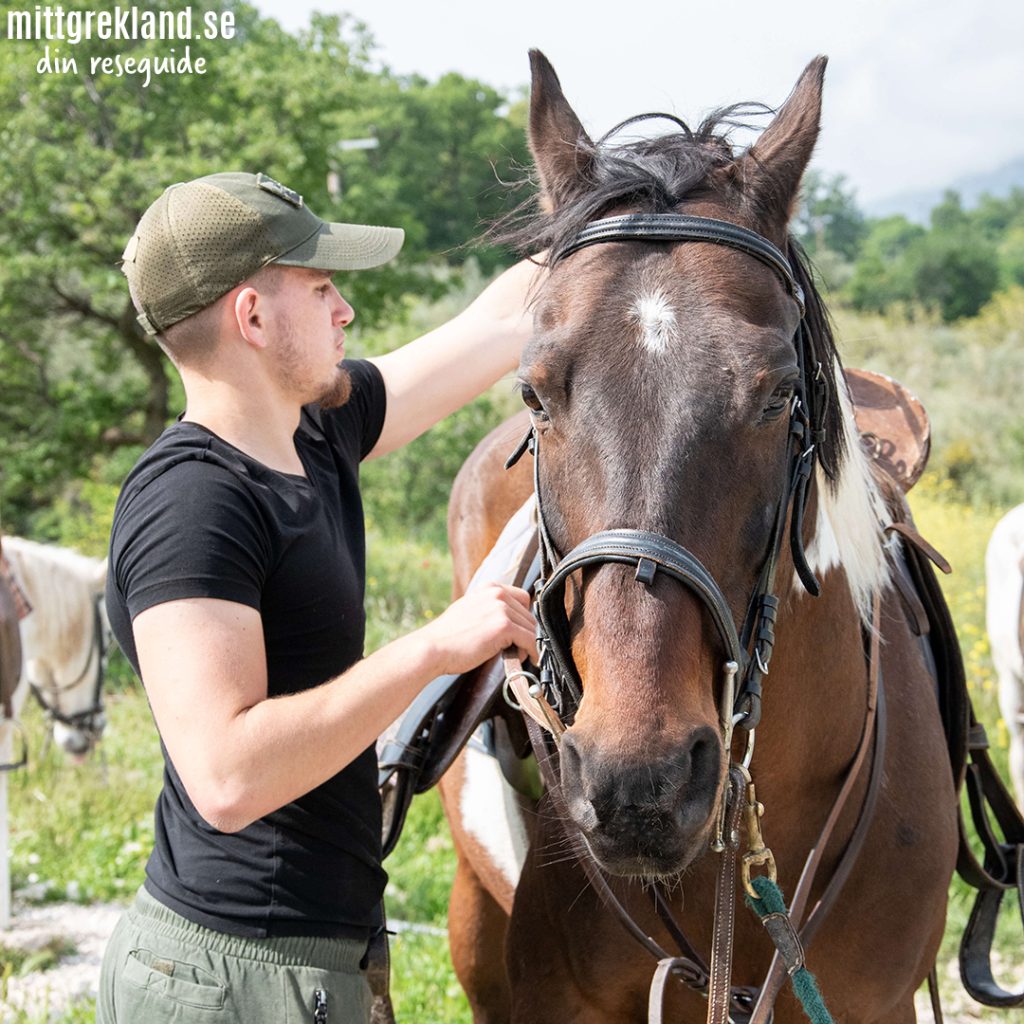
Speaking of wild horses, there are also domestic horses in the area. If you want to get on a horse, head to the Free Horse Riding Center (link) in the nearby village of Rethi and take a guided tour of the grounds. End with a coffee or a bite to eat at Φύση και Όν Physi K On (link) and enjoy the surroundings, which in springtime is full of colour.
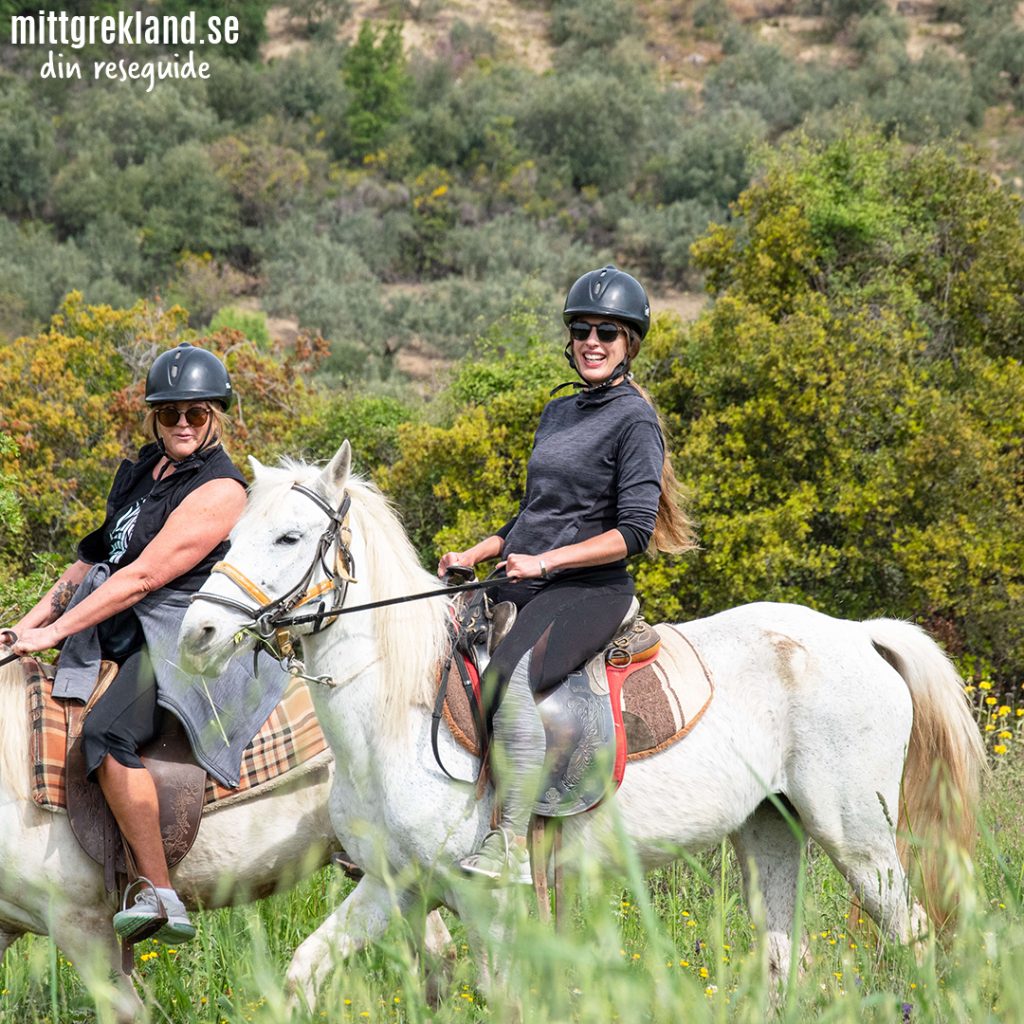
Hike to Trikala waterfall
There is something fundamental about walking, getting from one place to another on foot. I love it and I think it’s a great way to discover a place or an environment. For me, hiking means feeling nature on a deeper level, feeling structures, smells and challenging oneself.
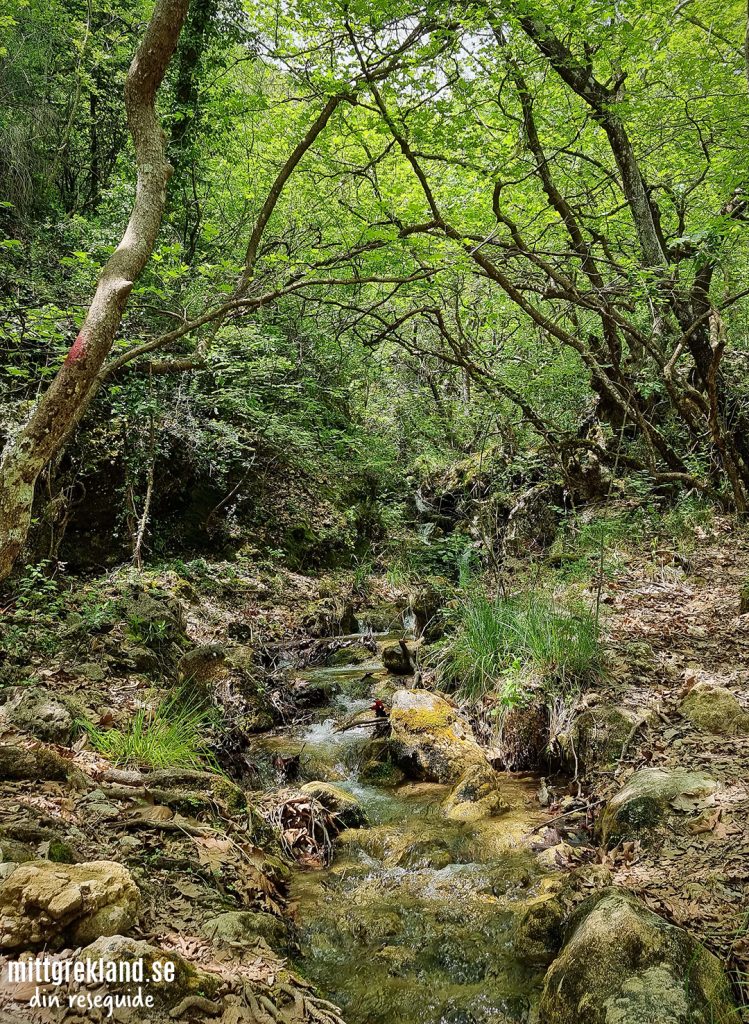
In Trikala there are several hiking trails and even more are createds. Hiking tourism is in Trikala is growing and given the area’s fantastic nature and views, it really is a fantastic place to experience on foot.
On the morning of day two, we set off for the waterfall in Trikala, amazingly a rather newly discovered gem. For decades, growers have diverted water from the creek that flows into the gorge, but it’s only been a few years since they actually followed the creek all the way to its source. And there! In the middle of it all was this wonderful waterfall (see the video in the beginning of the article).
The hiking trail is not particularly demanding but has parts where, due to the slope, you need to hold on to the set ropes. If it has recently rained a lot (as it did for us) it is important to use your balance when you zigzag across the stream on small stones.
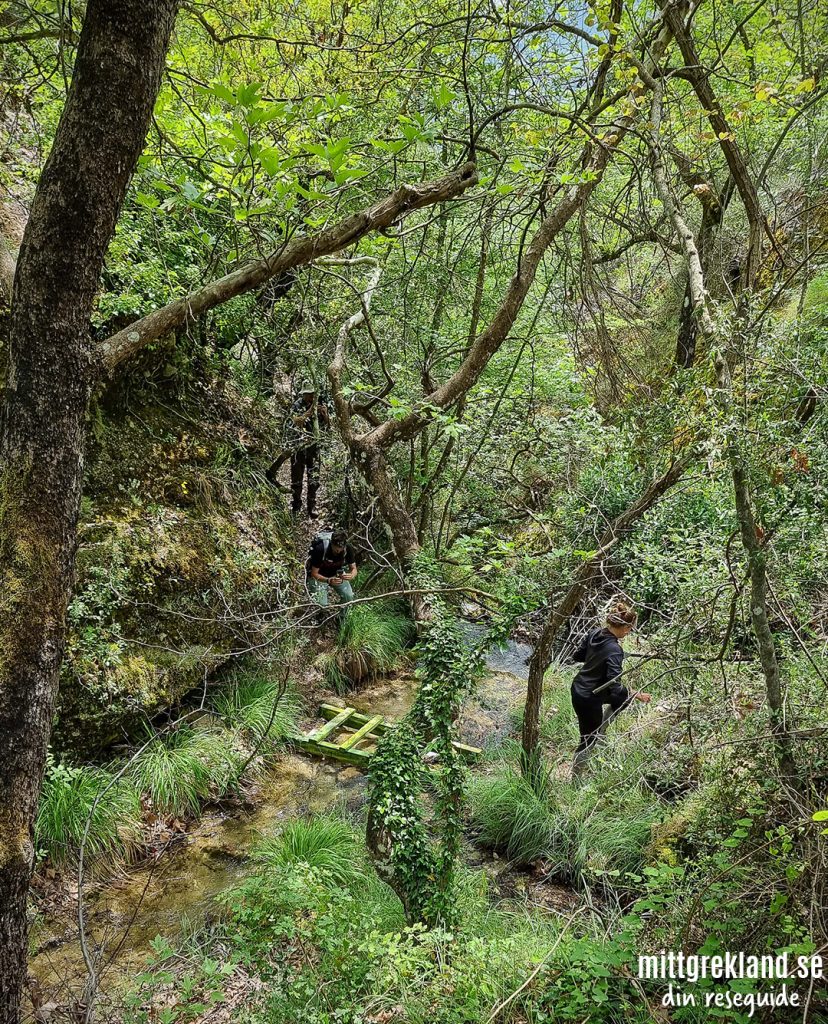
The trail starts by the road and continues along a cast water channel and then leads down into the gorge. The forest creates a green and lush space and the only thing that is heard are nature’s own sounds in the form of rippling water and birdsong. It smells of earth and vegetation. It is a liberation to be beyond man’s own creations and to be surrounded by nature.
After barely 30minutes we are at the waterfall and it is worth every second of effort.
Monastery of Agios Vlasios
Although I am not a religious person, I cannot help but be fascinated by the history that different religions have created. In the region of Xylokastro- Evrostina (Peloponnese), there are several historic buildings connected to religion that are well worth visiting. For me, it’s usually about being able to visit a place in a kind of harmony, a beautiful place, a place for time for reflection.
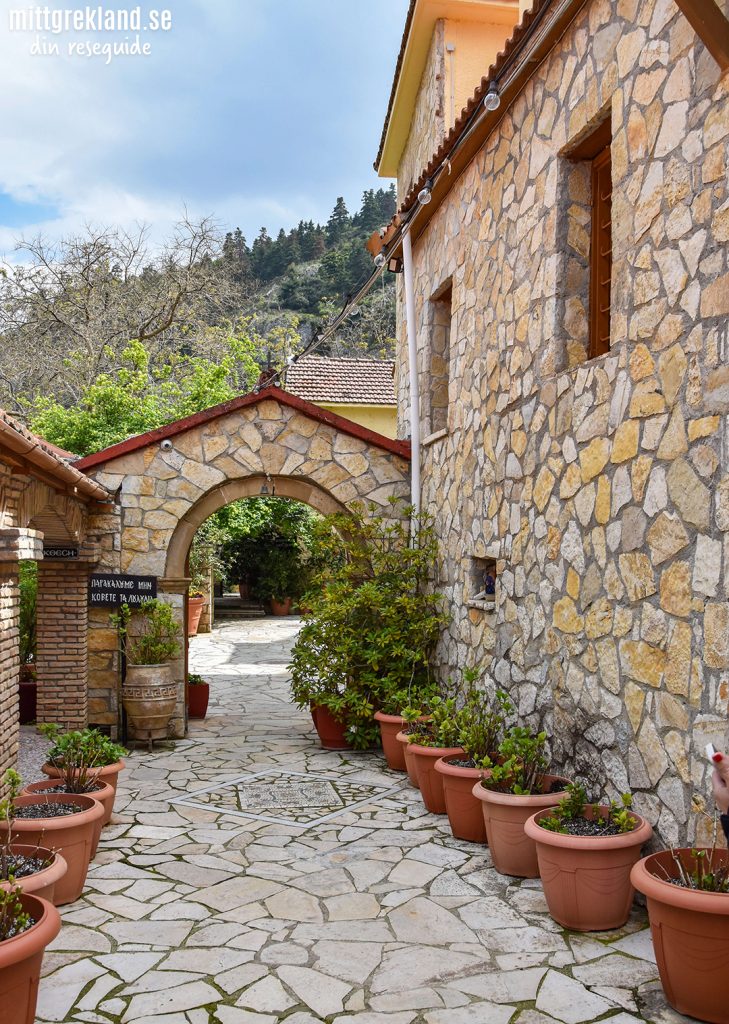
The monastery of Agios Vlasios is just such a place. The monastery is located just two kilometers from Trikala, nestled in the greenery on the north-eastern side of Mount Ziria.
Legend says that a 7th-century wooden carving of Saint Vlasios was discovered in an inaccessible cave nearby. The discovery inspired the construction of a temple that stood on the same site as the monastery does today. There are no traces of how long the temple stood on the site but the current monastery was built during the mid-17th century. A smaller extension was added in 1918 to create a ”women’s room”.
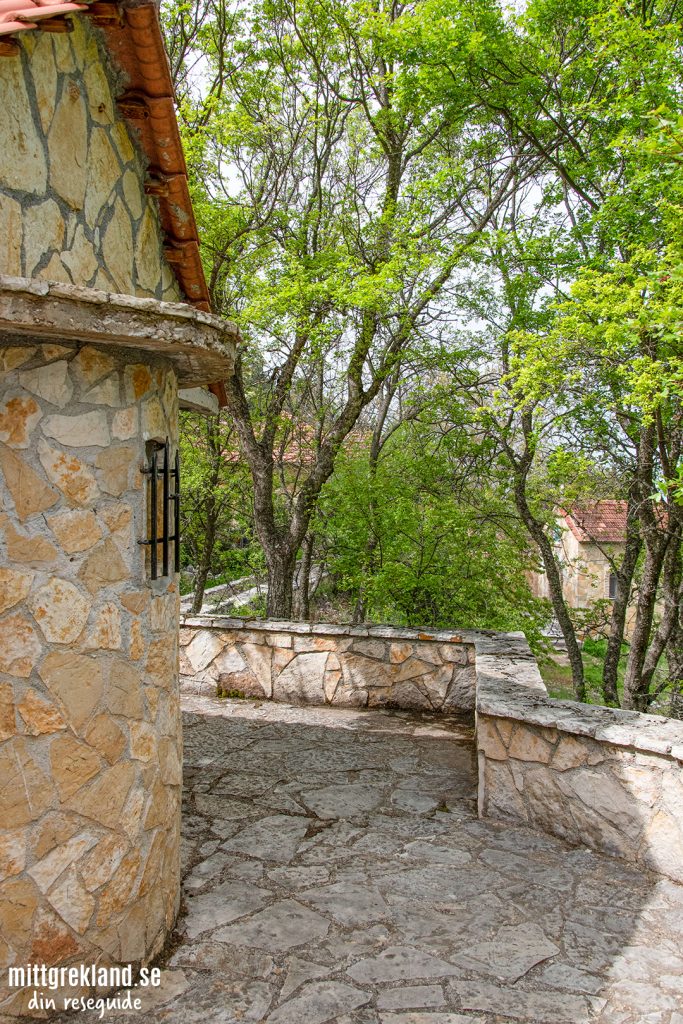
The monastery is still active and when you visit Agios Vlasios, you can be sure of that the nuns offers you both ”spoon sweets” and a cup of coffee.
Monastery of Agios Georgios and Lake Doxa
Another monastery located in an adorably beautiful location is the monastery of Agios Georgios near Lake Doxa (a part of the Natura 2000 network). The monastery was of great importance in above all the revolution of 1821. Among other things, they had a secret Greek school to be able to continue teaching the children of the area knowledge based on their own history and culture.
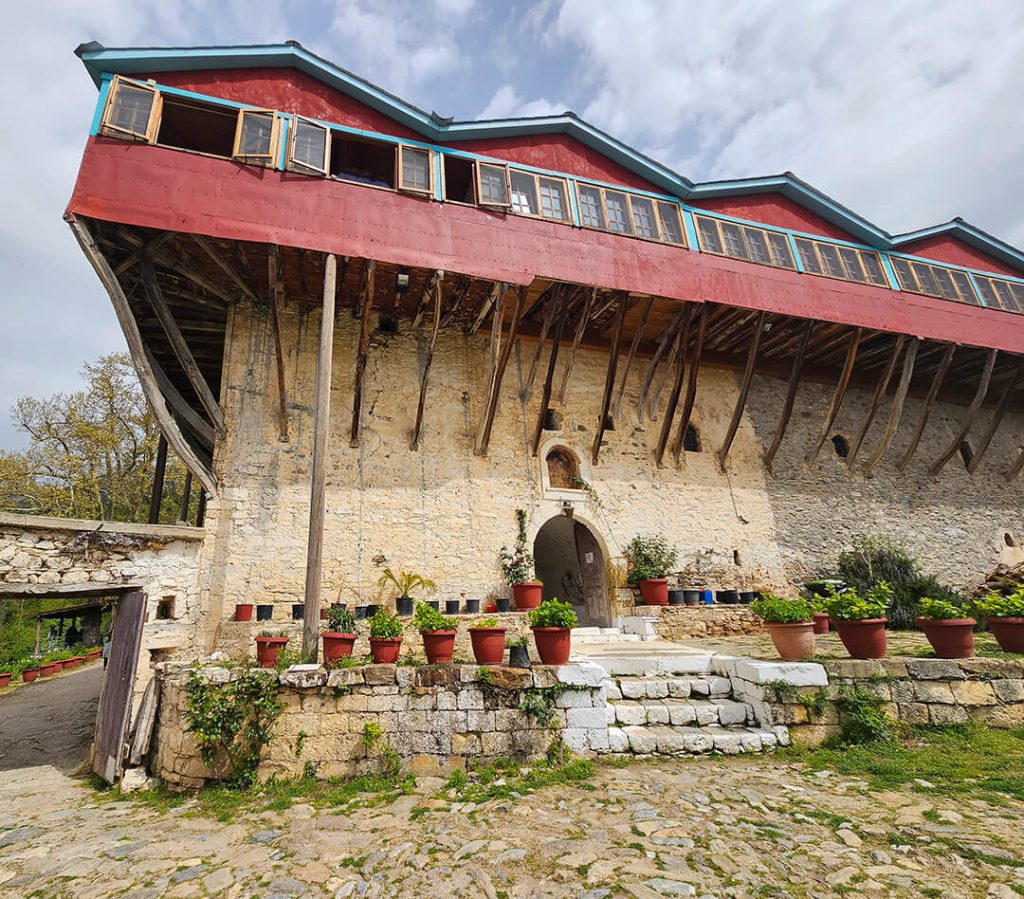
In addition to its historical significance, the monastery is known for its ”spoon sweets”. These spoon sweets are made with the flavor of roses, a timeless symbol of spring, eternity and the renewal of life.
Below the monastery is the lake Doxa, which is actually an artificial lake created in the 1990s to supply the plantations in the valley with water. However, that does not make it any less beautiful and spending a day here is truly a joy for the soul.
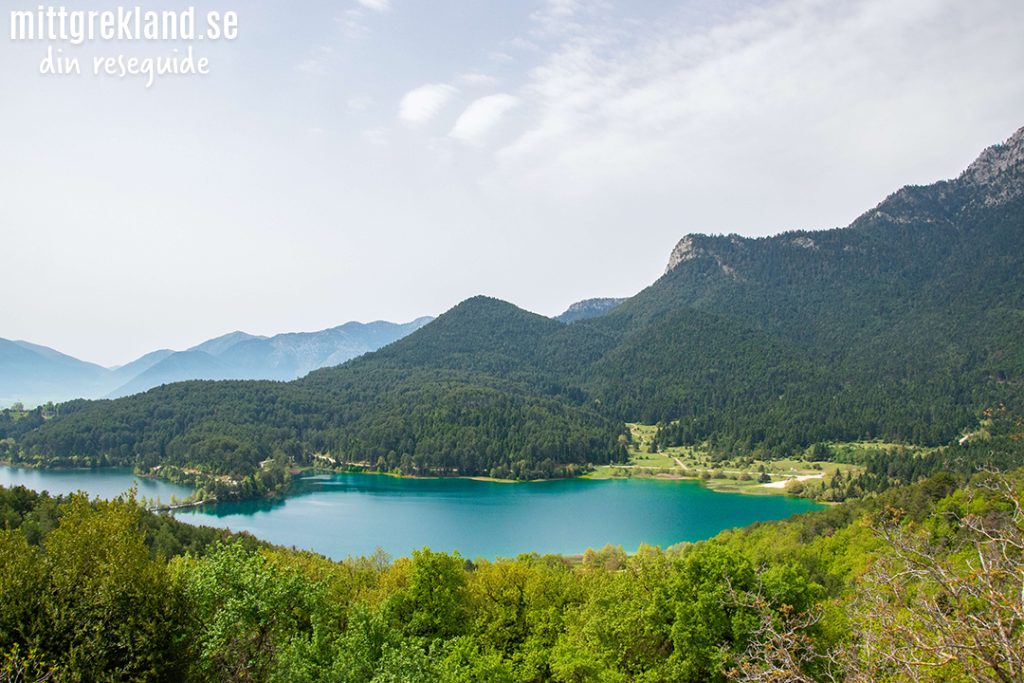
In the middle of the lake is a narrow strip of land that leads to the small chapel of Agios Fanourios. During the weekends, local vendors sell spices, herbs, cheese, honey, bread, tsipouro and more along the narrow strip of land.
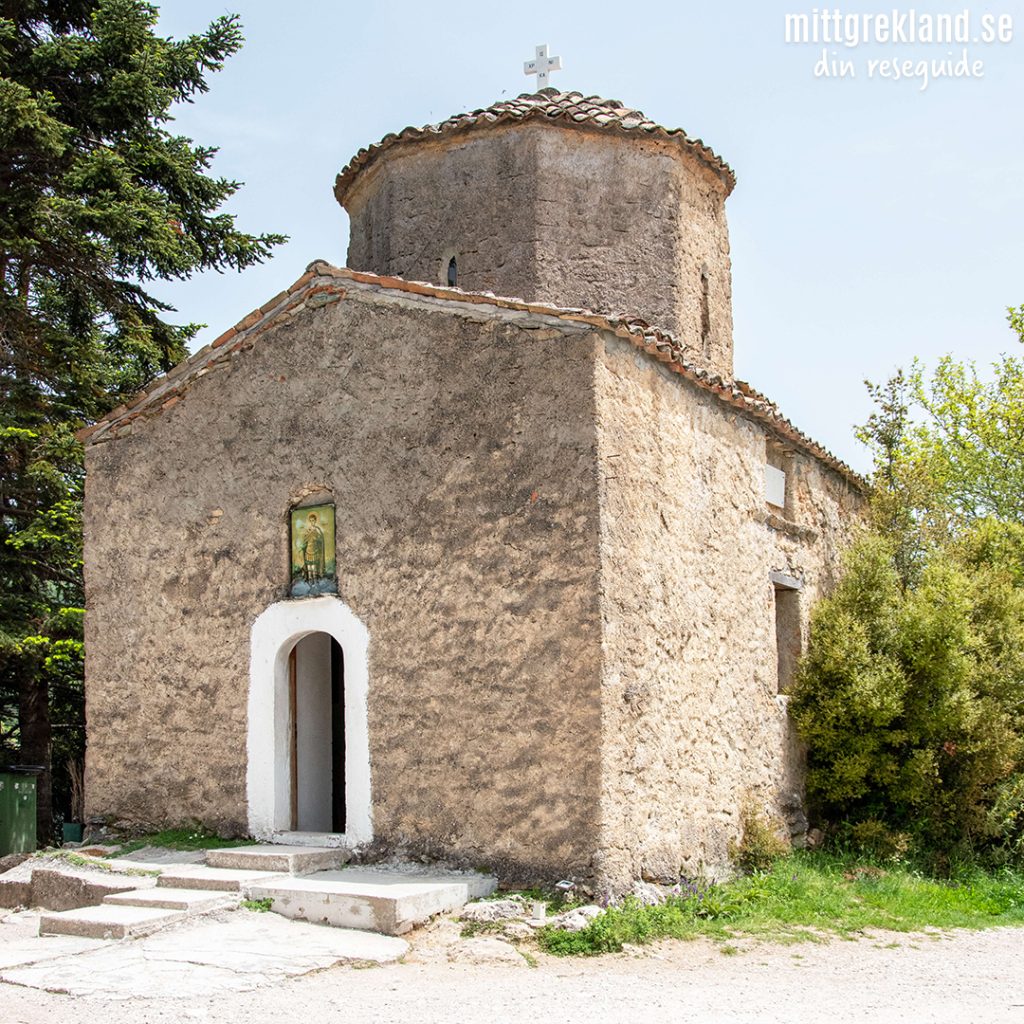
Lake Doxa, although man-made, is considered one of the most beautiful mountain lakes in Greece and in Peloponnese because the autumn colors of the forest are reflected in the emerald green water, creating a unique landscape. A reason to return in the autumn, in other words!
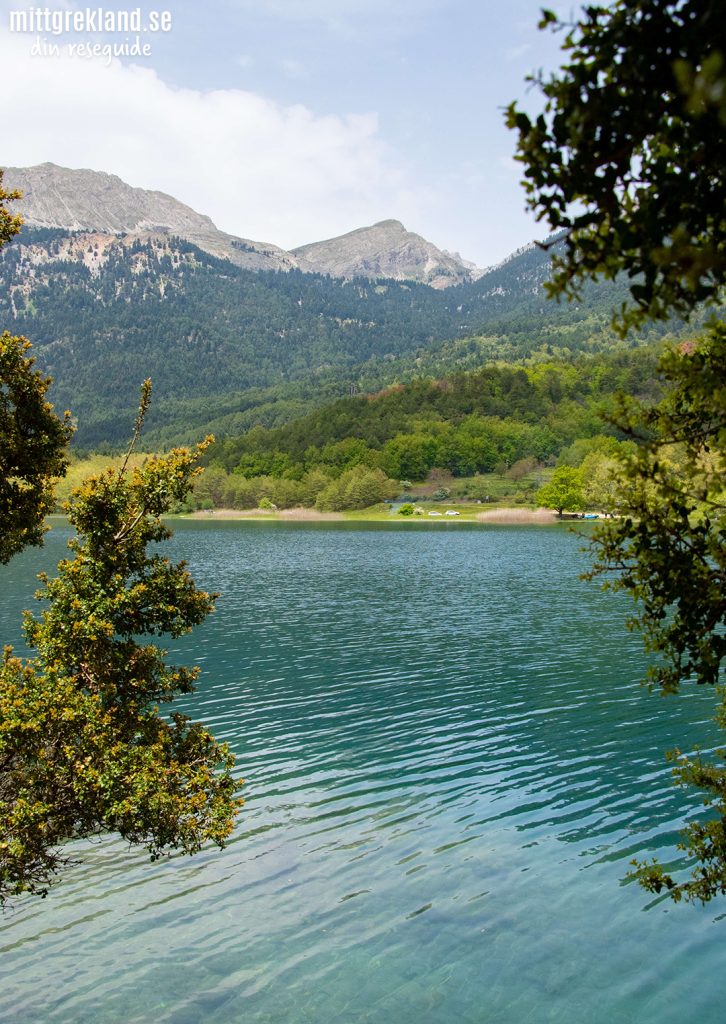
You can experience Doxa with pedal boats, a peaceful way to take in the surroundings, and not just from walking along the beach strip. You can find the pedal boats at Doxas east side.
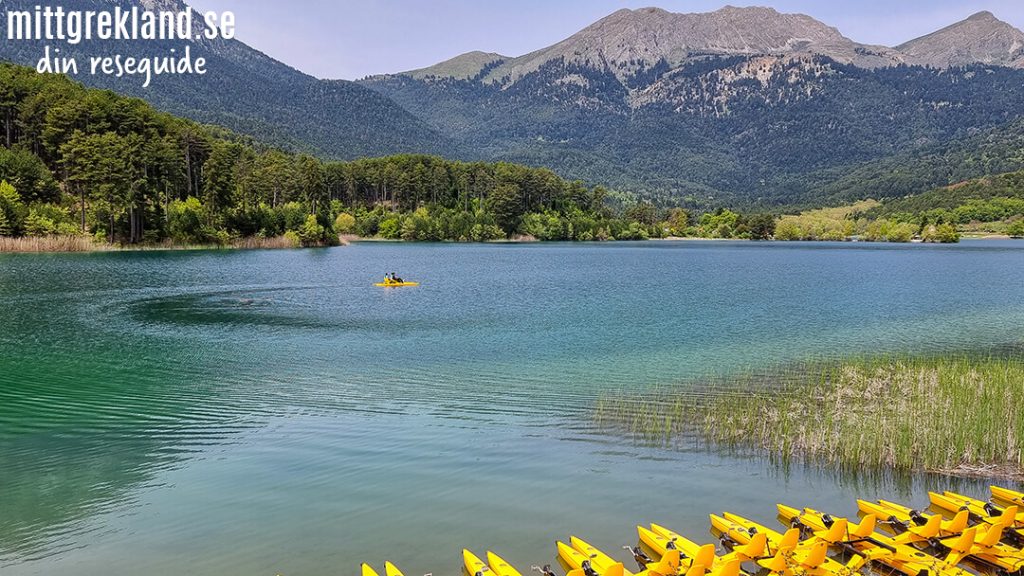
Restaurants
A trip to Greece always consists of food, food in large quantities, and in Trikala there are several really good taverns that cherish the local ingredients. You are offered everything from vegetarian dishes to dripping pieces of meat, often served with locally produced wine. A day in the mountains really makes you hungry and ending a day at one of the cozy taverns feels like landing in a really nice mountain resort. Often they are decorated with stone walls and wooden details and somewhere in the room a fire crackles in a fireplace.
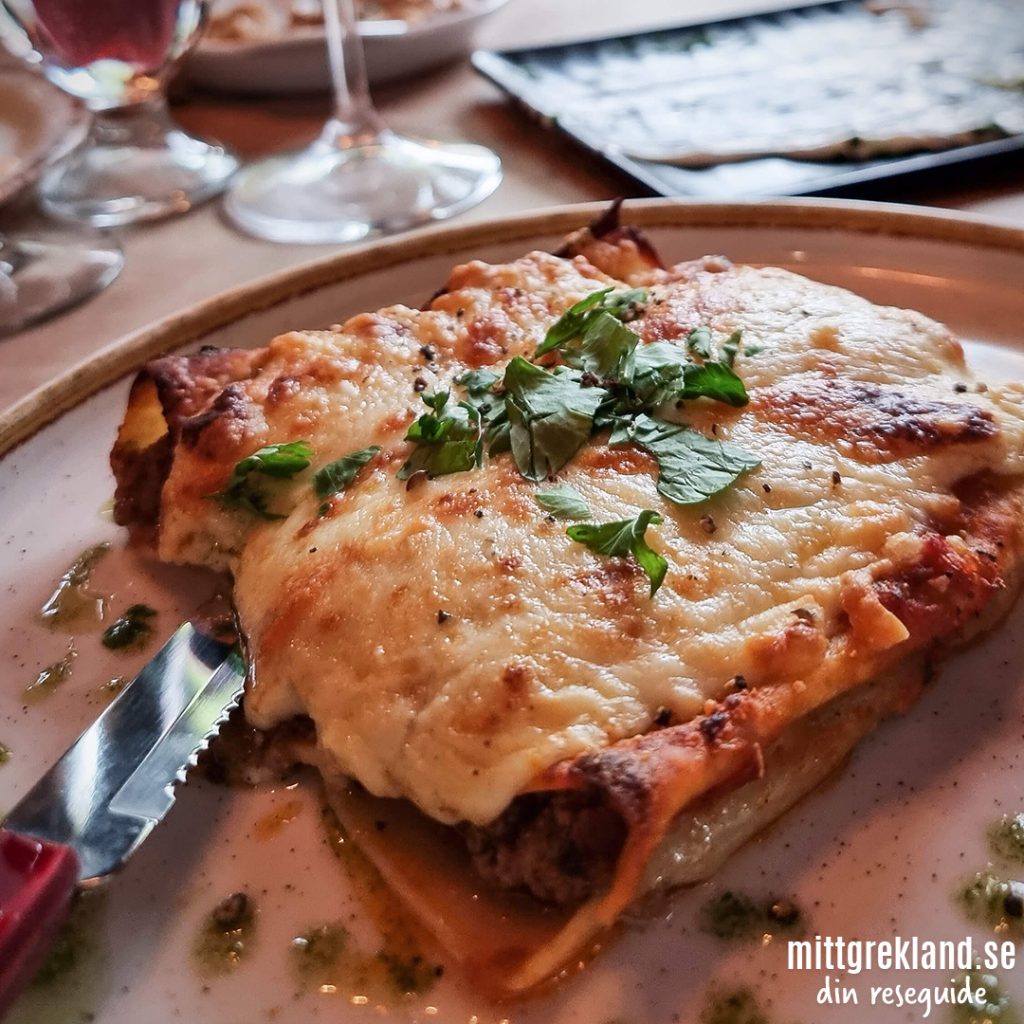
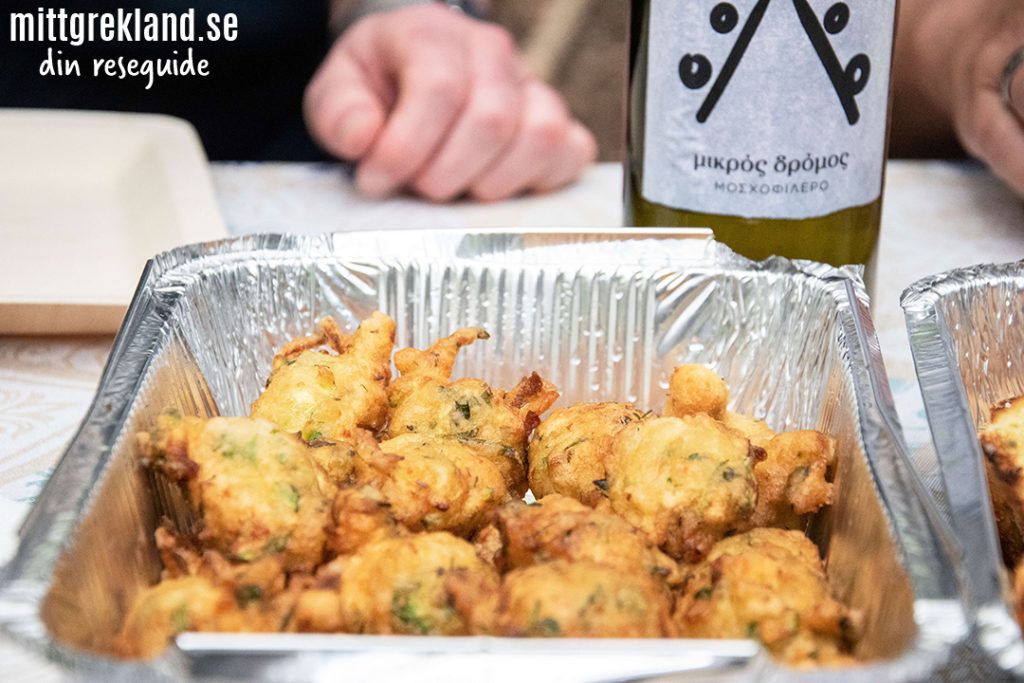
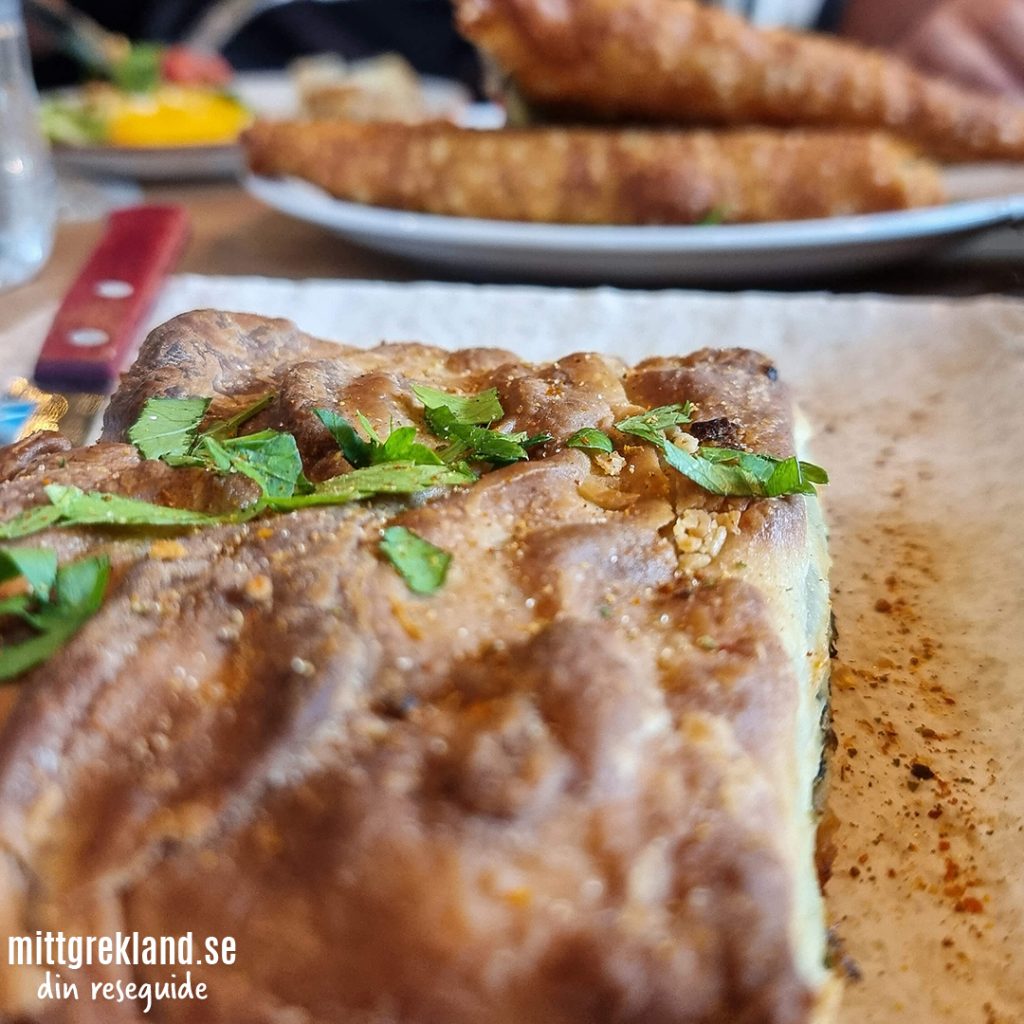
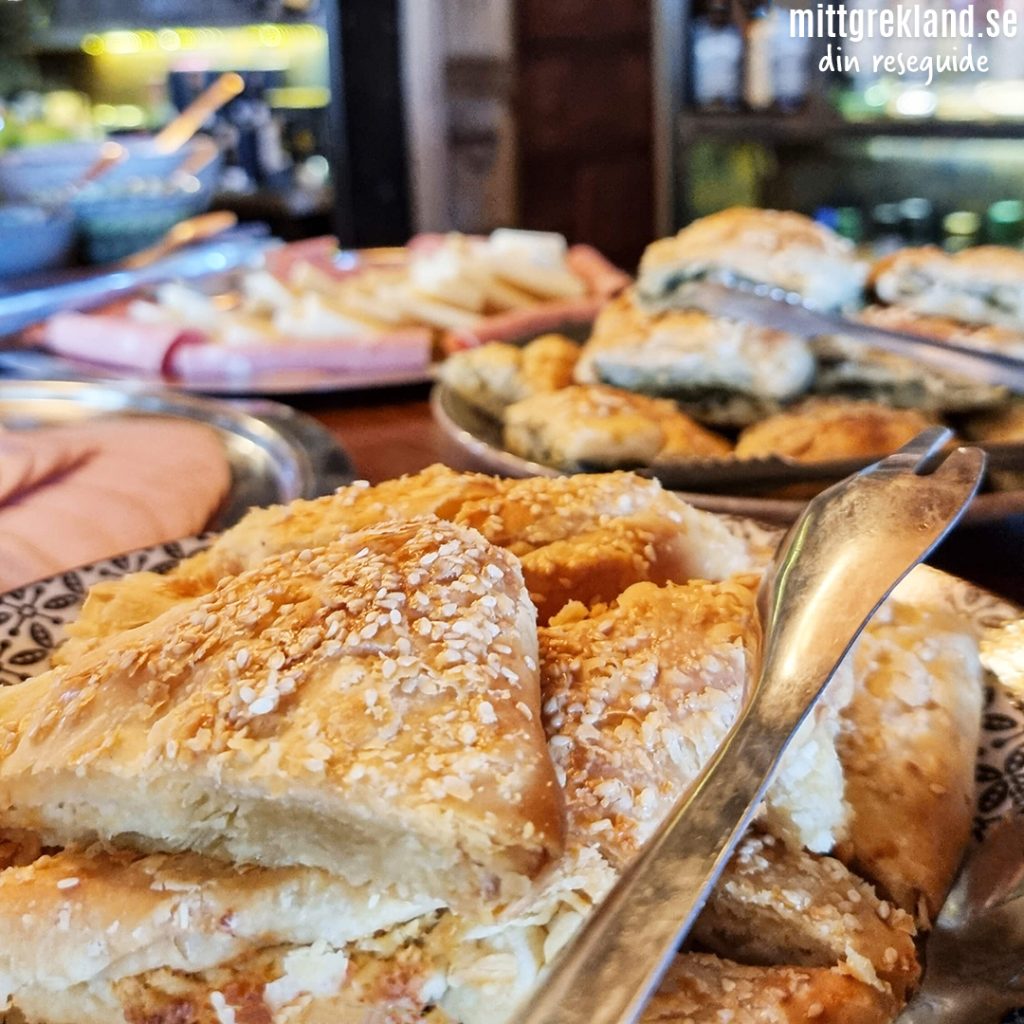
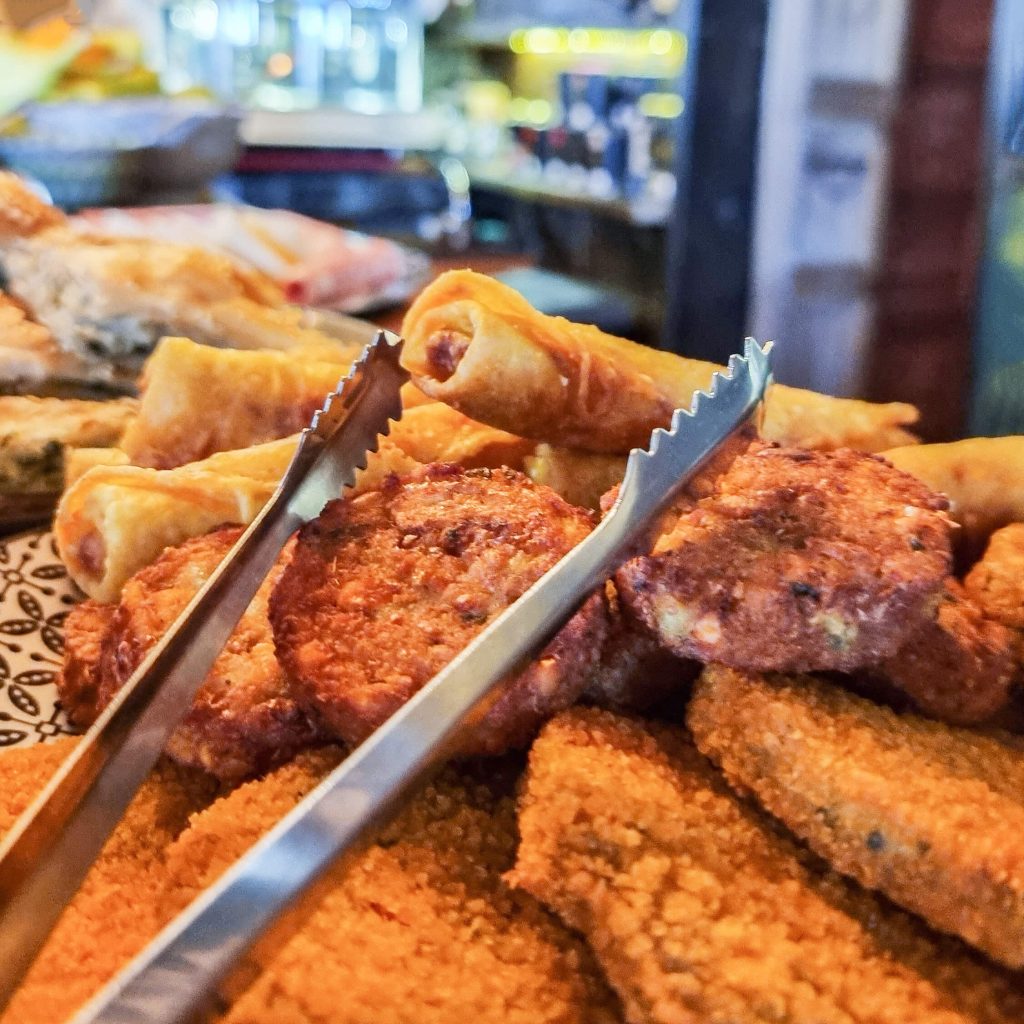
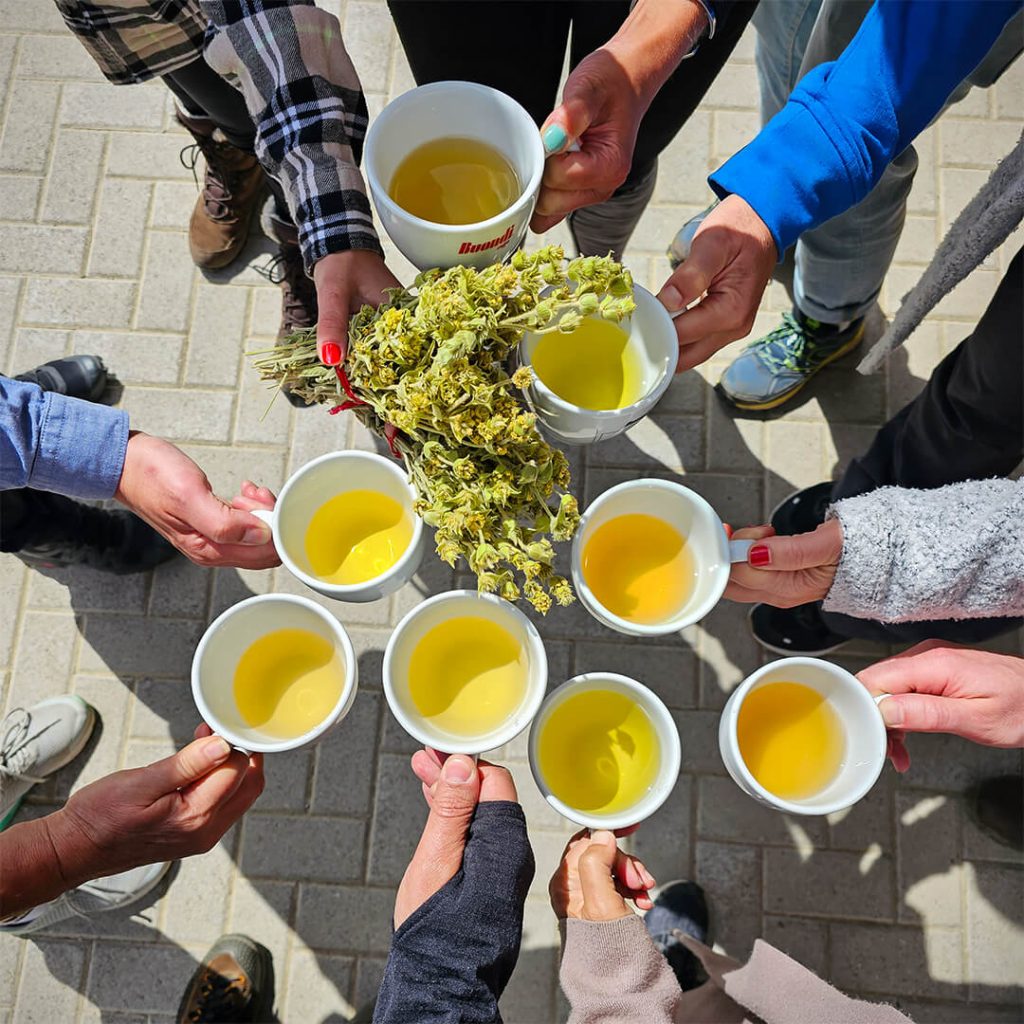
Some of the restaurants/cafés and taverns I visited:
Καφέ Αλφαβητάριο Café Alfvatario (link) in Kato Trikala
Ο Πλάτανος Taverna Platanos (link) in Kato Trikala
Στου Δεκλερή Sto Dekleris (link) in Ano Trikala
Καταφύγιο Γεύσεων Katafygio Gefseon (link) in Mesaia Trikala
Κιβωτός Kiboto (länk) i Ano Trikala
Guesthouse Aipytos
During my days in Trikala, I stayed at Ξενώνας Αίπυτος Aipytos (link), a great little guesthouse on the mountainside in the middle of Trikala (Mesaia Trikala). The view is priceless and it really has that feeling of being in the mountains. On the very first evening, the little lady who owns the accommodation offered to light a fire in the fireplace and to the sound of the crackling fire I lay for a while on the bed and looked at the sloping wooden ceiling.

I can still feel the scents of the fire, the feeling of beeing safe under the thick blanket and the cool tile floor that requires slippers as if I were there right now.
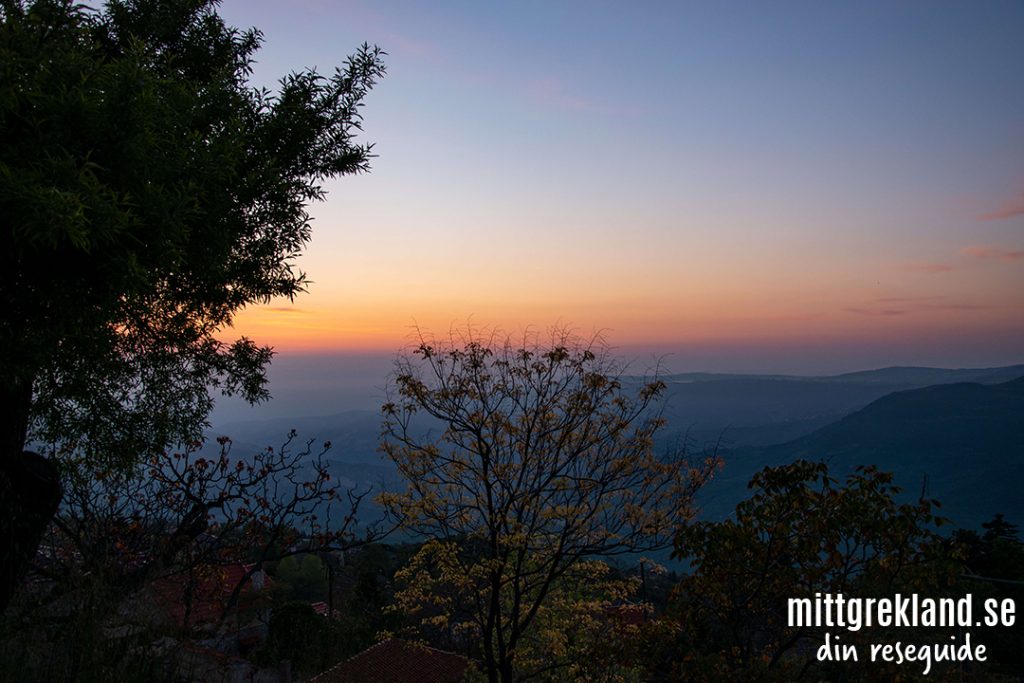
A few days in Peloponnese and Xylokastro-Evrostina and Trikala Korinth really add flavor to life and I will definitely go back soon!
The facts are from: https://www.xylokastro-evrostini.gov.gr/el/ (link)
Read more about places in Greece: Arachova (link)

